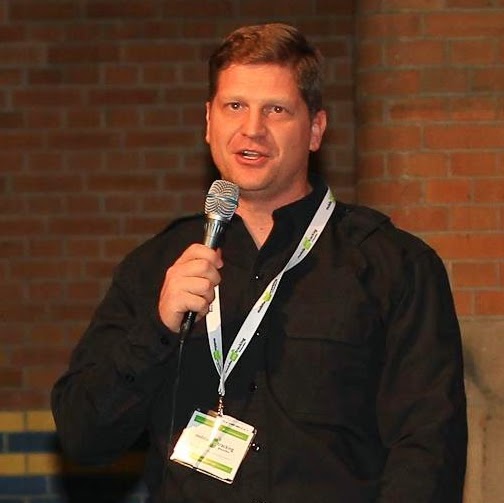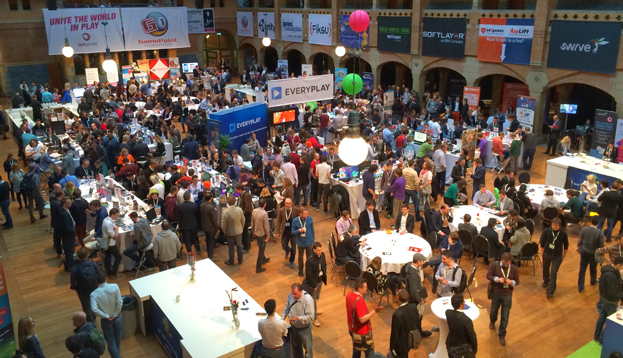The casual gaming market continues to see momentum, thanks in part to the booming mobile gaming sector. The organizers of the Casual Connect conference have been able to tap into this burgeoning market and connect the growing number of small development teams around the globe with the leading executives in the space. Over 2,000 attendees flew into Amsterdam last week from across Europe to make connections and get a preview of growth sectors. Next up is the San Francisco conference Aug. 11-13. Carl Quinton, production director at Casual Connect, explains how the conference is growing in this exclusive interview from Casual Connect Europe.
 Carl Quinton, production director at Casual Connect
Carl Quinton, production director at Casual Connect
How did Casual Connect begin?
Casual Connect began in 2005 when Jessica Tams, who was already in the industry, was approached by other people who were doing casual games that wanted a place to come together. They decided they needed their own conference because their needs were not being taken care of at current conference series, so her friends convinced her to start doing a conference instead of making video games.
How has Casual Connect grown since 2005?
The very first show in Amsterdam had about 400 people. Our next show in Seattle had about 800. We started off with three shows a year, one in U.S., one in Europe and one in Eastern Europe and we now do four shows a year. We’ve gone from an annual attendance the first year of somewhere in the range of 1,600 people to about an annual attendance of 7,500 people a year with the four shows.
How are you expanding the conference this year?
We’re going to Tel Aviv for the first time. We have a lot of excited partners and relationships in Israel who’ve decided that we really need to go there this year. We’re really excited to go there show everybody what’s happening in Israel right now. There’s a lot of things that people don’t know about there’s a limited set of people that can come out to our shows in the rest of the world. We’ll showcase the talent and funding and casino and game development that’s happening in Israel.
How big an audience do you foresee at that show?
I foresee that show being very close to an Amsterdam sized audience, somewhere in the 1,500 to 2,000 person range. I might be a little bullish on that, but it seems to be accurate with all the research that we’ve done.
How did your move to Belgrade, Serbia go because of the turmoil in Kiev, Ukraine, home of previous Casual Connect shows?
We had a couple of really good partners that were from that area, which the decision was centered around. Because of those partners we were able to go down their very easily, have a very similar-sized show with a very similar feel, and go with great success. Belgrade turned out to be a great host country. There are a couple of really large game development companies like Nordeus, Mad Head Games and Eipix down there and they were excellent hosts to everybody seeing Belgrade for the first time.
Will Belgrade now become a regular rotation?
Belgrade will probably come in the rotation. If we ever see some stability returned to Kiev, that will also be in the rotation and I’m also hoping to get Poland in on that rotation as well.
So for that particular area you’ll just rotate different countries?
Yes, we see that as an exploratory area where if we can move around and do things like that, we can probably generate a lot more new blood. And also because of the resources available there compared to resources in Western Europe, it makes sense to move closer to other people’s locations so that it’s economical for them to attend.
You mentioned Seattle being one of your earlier shows. These days it seems like San Francisco is your go to city. How did that kind of evolve?
There are a couple of things. One, we just outgrew our venue in Seattle and we couldn’t get another spot. Also, a lot of companies are in San Francisco, so it’s a lot easier to convince somebody to come down the street than it is to fly all the way up to Seattle. But the main reason really was the venue size. We’re actually looking to go back to Seattle in the future for a revival and depending on how things go we may stay in Seattle for a little bit. We may alternate, or we may stay in San Francisco. We’ll see how the community receives us when we go back for a revival in Seattle in two or three years.
Are you still looking at keeping it at four shows per year?
Right now we’re going to do four shows per year. I would like to expand beyond that, but probably in a different format, something that would allow us to do some additional areas that are interesting to me. I would love to go down to South America. There are other regions that I’d like to give a little more attention to, maybe not with the same presence that we do the other shows, but I’d really like to involve those other areas as well.
Can you talk about your expansion into Southeast Asia?
We’ve really been able to reach out to the Southeast Asian development community and companies down there. We have really strong ties with them. We’ve done little mixers around there and have made a lot of great connections. They all come around to Singapore. And we did a small event in Beijing last year. We’ve started to get a lot more input from them on what we need to do to involve them in what’s interesting to them. I foresee us slowly expanding in that region to involve pretty much the entire area. We have some ideas there and we’re going to see how they execute over this next year and make adjustments from there.
Hong Kong remains the current focus, correct?
We were focusing on Hong Kong, but there are some alternates. I’m pushing for Macau and some other people are pushing for other countries. We have various strategic people in our company that are investigating different areas as their expertise, and then we’ll make plans from there.
Do you see Southeast Asia becoming like Eastern Europe where you could rotate cities from year to year?
We could rotate. We could have one be like the big Amsterdam hub event and then have another be a rotating event like we’re thinking about doing in Eastern Europe. That’s all still in flux. The whole idea is we want this to be a truly international event. Whatever we need to do to make it so that more people know about what’s going on in the games industry and can make more games for everybody, we’ll do. Casual Connect is about making games for everybody and we want to reach everybody that wants to make games in that same respect.
How big was the Beijing event you did?
We were in the 200 to 300 range. It was just a one day thing and we had a couple of partner sponsors that helped us out. We took advantage of the 72-hour Transit Visa that just went into effect, so we dropped in on the way home from Singapore.
How does Casual Connect differ from GDC, Game Connection and other game conferences?
What we do differently is we’re more personable. We’re a tighter knit community in that I personally know 300 of the 2,000 people that came here to Amsterdam. There are so many people here that have been in the industry 20-plus years. Derrick Morton from FlowPlay games has 21 years in the industry doing casual games and they’re just. There doesn’t seem to be the fluff here. Everybody’s passionate about the industry. Nobody’s here to just grab swag. Everybody here is at director and CEO levels of companies and they’re here to do business and to figure out what’s next in the game industry. Kabam came to Singapore a couple of years ago and made a completely different change in their strategy and was able to take advantage of that based on discussions the CEO had. TinyLoot’s founder started out in Casual Connect about nine years ago as a student volunteer and has progressed his way through different lectures and opportunities making partnerships with people here to basically build his business from the ground up. There are success stories like that which show how we’re almost a business incubator and business relationship generator.

